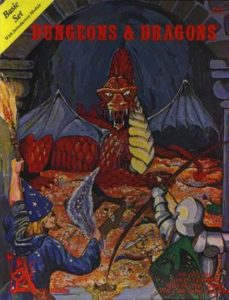
Basic Edition (1977)
Last time I wrote of my praise for Monsters and Manuals, a long-running blog on role-playing games. How I came across Monsters and Manuals is a story itself.
In 2012 I somehow found myself reading a now-defunct Dungeons & Dragons blog called Grognardia. Now, I haven’t played D&D since Ronald Reagan was president, although I was active in the game throughout the 1980s. Why I came across the blog is long-forgotten to me, but there I was reading about D&D in theory and operation.
Grognardia was a bit of a revelation: People—adults—were still playing D&D, even after the rise of the Internet and smart phones and hellaciously ambitious video games. For years I’d thought back on D&D as an odd teenage avocation of mine, a 1980s trend that faded with Rubik’s Cube and glam metal. For me in 2012, the image of four to eight people around a table with paper and pencil rolling saving throws was a sepia-tone daguerreotype of a more innocent age. Now I know better. D&D (and role-playing in general) has changed and evolved, but it’s still going strong.
Reading Grognardia for the first time made me feel like Mel Brooks’ 2,000 year-old man stepping out from a 33 A.D. time capsule and discovering people are still abuzz over that Jesus guy. I lost contact with D&D after 1987 (or so) and Grognardia was my re-introduction to the community. Amazingly, I found the community was talking about the state of D&D prior to 1987.
Reading Grognardia’s love-letters to Gary Gygax, co-creator of D&D, and its many tributes to old-timey role-playing was a massive syringe injection of nostalgia. Reading closely, I deduced blogger James Maliszewski was about my age and had been introduced to D&D around the same time I was (the late 1970s).
Grognardia gave Maliszewski a platform to lay out his dim, gimlet-eyed views of the state of D&D in the 2000s. In fact, Maliszewski held a pretty dim view of all things D&D after about 1983. (“Dragonlance Ruined Everything”, “I Hate Change”) His scheme of D&D’s eras has the game exiting its Golden Age before 1983 and waving goodbye to its Silver Age around 1989. From there, in Grognardia’s estimation, Dungeons & Dragons was downhill.
Maliszewski’s writing is forceful, lucid, and mostly consistent. The early Grognardia posts were manifesto-like, each chiseled from a bedrock belief in old-school D&D, each post a brick set in mortar like a fervent parishioner building a country church by hand. His brimstone sermons on original intent and calls for a return to the soil earned him a wide fan base at his blog’s height a decade ago.
Alas—and you probably saw this coming—cracks in his reputation began to appear not long after I began reading his blog. (Like most Internet dramas, it’s a mildly complicated story and better explained by him and others.) Grognarida ceased updates soon thereafter, and I so searched for a replacement blog to fill the nostalgic void. That’s how I discovered Monsters and Manuals, which I’ve been reading ever since.
While writing my last post, I spent some time revisiting Grognardia. I’d not read it since my first encounter in 2012. The reread gave me a new appreciation for Maliszewski’s idiosyncratic but thoughtful perspectives. Back in 2012, his posts forced me to evaluate (and reevaluate) my memories of D&D and its impact and history. In my reread, I found myself returning to those evaluations once more.
I’m by no means a D&D insider, so my thoughts on the game may earn a collective yawn from the community, but I’ll record them in future posts in case they’re of interest to anyone.